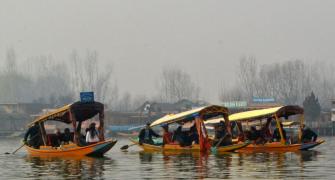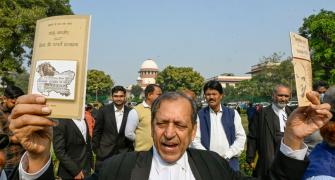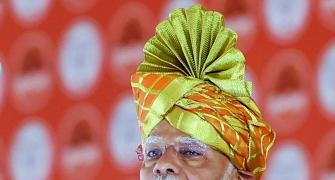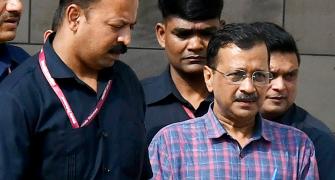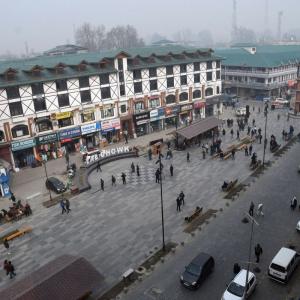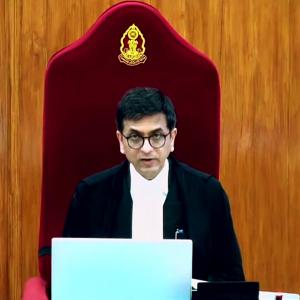We must heed what the CJI has said. Challenging every judgment of the central government is inviting chaos, asserts Shreekant Sambrani.

I have never written on legal or Constitutional issues, but as a conscientious citizen, I am more than slightly interested in them as they emerge before us.
On December 12, I was reading online the main points of the Supreme Court judgment on the abrogation of Article 370 of our Constitution, now more than four years old.
I was very pleased with most of what I read and understood, and spontaneously shared my reactions with a few good friends, including the editor of Rediff.com.
He suggested that I write a column on the subject.
When I demurred because of what I thought was a very solid reason that this was really much beyond my ken, he felt that he could use a non-legal, but informed, person's views.
So here I go barging into a territory where angels fear to tread, reader beware!
In what follows, I have drawn from what I understand of constitutional issues of the United States.
Right from my student days in the 1960s, the American system of jurisprudence, especially the Supreme Court of the United States (SCOTUS), has been much in the news and its analysis.
The views and written opinions of SCOTUS justices are quite well-documented and discussed by the cognoscenti.
There are only nine US justices at most at any given time. They enjoy life-long tenures.
Their views prior to their appointment to the apex court are thoroughly scrutinised in the US Senate confirmation process.
And SCOTUS has no benches; all cases before it are heard by all the justices and the majority view prevails.
The justices also deliver numerous lectures and discourses during their term in offices.
Further, the Court is very selective in what cases it chooses to hear. In any given year, they probably would not cross the three-figure mark,
All this makes it far easier to understand how SCOTUS works and the principles that guide the justices' opinions.
In contrast, our Supreme Court has a sanctioned strength of 33 justices. They also have relatively short tenures in the court, as they retire at the age of 65.
They hear cases singly or in benches of various strengths. The number of cases they hear every year is far larger than that of most other national apex judicial bodies.
There is also a plethora of public interest litigation and direct pleas for Supreme Court intervention on current issues that get priority hearing.
All this makes it quite a complicated task to track and understand the Supreme Court justices' decision processes.
In fact, except for active members of the Supreme Court Bar, most people would be hard put to name more than a handful of justices.
Only a few opinions, including those of the Chief Justice of India (CJI) ever get specifically analysed. Most of other jurists' views remain relatively unknown.
The current CJI, Justice D Y Chandrachud, is exceptional. He is among the rarest of the rare of his ilk, known as much for his erudition as for his eloquence in voicing his views.
And he has a relatively long tenure (in the Indian context) of over two years, during which time, by a remarkable coincidence, many precedent-setting matters have already come up for decision and many more are on the way.
The CJI seems to blessed with excellent clarity of mind and purpose, backed by encyclopaedic knowledge to handle this mammoth task.
Actually, my drawing on the SCOTUS experiences is of a piece with how legal matters are decided.
All courts everywhere in the world rely heavily on precedents, comprising opinions of well-known jurists from everywhere on similar issues.
'Precedent is nine-tenths of the settled law,' goes an old hoary chestnut.
The SCOTUS justices do not subscribe to a common, universal view of their constitution.
Until the last decade, the court was considered more liberal than the country at large, taking a very wide and accommodative view of constitutional provisions in the context of the prevailing situation of the American society, including on sensitive issues such as racial and gender equality, freedoms guaranteed under the first three amendments to the Constitution and above all, human rights.
The result is a steady erosion of the State's ability to intrude into personal lives and simultaneously, a greater vigilance over what public institutions, and even those deemed public, may or may not do.
That has changed lately. Many eminent scholars and jurists now adhere to a literal understanding of constitutions.
Justice Amy Coney Barrett, the last SCOTUS appointee of Donald Trump, is known to be a strict textualist, a proponent of the idea that statutes should be interpreted literally, without considering their legislative history or underlying purpose, and (of the original-public-meaning (external link), rather than original-intent (external link), variety), a proponent of the idea that the Constitution (external link) should be interpreted as perceived at the time of enactment.
Such a position would appear to be at variance with the history of constitutional evolution of the US.
The American constitution is the oldest codified one in the world, dating back to its ratification in 1789.
It is also among the shorter ones in the world, comprising only 7,760 words and amended only 27 times in its 234-year history.
By contrast, the Indian Constitution is almost 20 times as long, with 146,385 words, the longest in the world by a very long margin. It specifies not just principles but also procedures and other details. This prolixity of overspecifications has led to its being amended 105 times until 2021, roughly an amendment every eight months!
The US constitution was written when slavery was legal and many founding fathers and signatories of the constitution were owners of slave themselves, some even had very large slave-holdings.
They saw no conflict between the institution of slavery and the lofty ideals they had written into their constitution. Such was the moral order of the day.
They had, in fact, worked out a formula of equating a free black person as being equivalent to three-fifths of a white person to arrive at proportional representation for the 13 original American colonies forming the new republic of the United States of America (the famous Virginia Compromise).

The same United States fought a bloody Civil War with the slave-owning Confederate states on the question of abolition of slavery under the Thirteenth Amendment to its constitution some 'four score and seven years' later, as the Great Emancipator, President Abraham Lincoln, so memorably put it in Gettysburg Address of 1863.
Abolition of slavery may have needed an amendment to the US constitution, but most of the major strides of the country's march to greater equality among races were taken without such enabling provisions.
Courts at various levels have long ago abandoned the Virginia Compromise formula in favour of strict equality of individuals regardless of their race, creed or gender.
They have interpreted various clauses of the basic Constitution to facilitate this progress.
Arguably, the US today is among the most equitable societies and still under the same constitution that once condoned slavery.
Or take the instance of the First Amendment guaranteeing freedom of expression.
At the time of its passing in 1791, print was the only medium of mass communications.
Yet the principle involved in it has been interpreted as governing all media to enjoy the same guarantee.
If Americans today have the greatest freedom of expression in the world in their print, electronic and social media, it is because of an evolving interpretation of a constitutional amendment passed about 230 years ago, when the last two media were not even a twinkle in anyone's creative imagination.
Yet the same cannot be said about some other issues. The Second Amendment protects the Americans' right to bear arms to defend themselves.
This was enacted at a time when the society was unsettled with little by way of protective law and order machinery and a constant state of conflict, often armed, prevailed.
That situation has long vanished. Yet extremely powerful gun lobbies have prevailed in ensuring minimal federal control over individual ownership of firearms.
Crimes involving wanton shootouts have now reached an epidemic proportion and even presidents such as Barack Obama and Joe Biden can do little more than wringing their hands.
Donald J Trump actually championed the cause of gun ownership and enjoyed huge support of the National Rifle Association, possibly the most powerful lobby group in the US.
SCOTUS has been by and large a mute spectator.
Last year, the court reversed its long-held position on abortion rights of women.
That has led to trigger response from most Republican states imposing bans of various kinds on abortion.
The US has gone from being one of the most liberal nations in the world to being one with antediluvian views on abortion.
Thus, the same institution -- SCOTUS -- and the same instrument -- the US Constitution -- have acted in ways that appear to have had diametrically opposite consequences for the society.
In the case of civil rights and freedom of expression, they have had a liberating and positive influence, while in the case of gun control and now female reproductive rights, they have been quite detrimental to societal well-being.
This seeming paradox arises because of how a country views its constitution.
If it is seen as not just the basic law of the country, but also a statement of core beliefs of the people of the country, it becomes a living document, representing not merely the timeless values of a people but also of the rationale that should govern their actions in the prevailing circumstances.
This latter imparts a dynamism to the constitution, unlike the country's laws which are static in nature and may be subject time limitations, the so-called 'sunset' clauses.
Obedience to the constitution emanates from a sense of commitment and dedication.
On the other hand, if the constitution is seen as requiring observance to the strict letter, and that too, in the manner expected by its framers, it would be seen as yet another law to be obeyed out of coercion.
It ceases to be a living document and could well turn into an instrument of oppression, like orthodox religious dogma.
Such a situation is not tenable in the long run.
It could lead to anarchy, as it did in the US when the Eighteenth Amendment in 1919 prohibited the making, transporting, and selling of alcoholic beverages nationwide.
It was observed more in defiance than compliance, leading to widespread influence of crime syndicates of bootleggers.
It had to be repealed by the Twenty-first Amendment in 1934.
A similar situation prevailed in most of Western Europe where abortions and divorces were illegal under the influence of the Church.
Gradually, these provisions were abandoned (but not Christianity) under prevailing social situations in the countries.
This rather long preamble helps us see our own Supreme Court's position on the erstwhile Article 370 relating to special provisions for Jammu and Kashmir in the right perspective.
The Article became a part of the Constitution adopted in 1948 when the erstwhile princely state's accession to India was still very much a work in progress, threatened as it was then by attacks from Pakistan, which had occupied large chunks of the territory claimed by the Dogra kingdom.
It conferred certain property rights on the subjects of the kingdom, barring its alienation to outsiders and recognised the role that a constituent assembly for the territory could play.
It was our equivalent of the Virginia Compromise before the adoption of the US constitution, triggered by prevailing reality.
Over time it changed. While Pakistan still claims the Kashmir valley as a disputed territory, its incorporation into India is now an accomplished fact after 75 years and three wars with that country.
The local constituent assembly ceased to exist in 1956.
The head of the government of the territory is now designated chief minister as in other Indian states and union territories, and the titular representative of the central government the governor and not prime minister and sadar-i-riyasat respectively as in the period immediately after the accession.
Elections to the state assembly have been held from time to time under the aegis of the Election Commission of India, however flawed they may have been.
The writ of the Supreme Court now prevails there.
The CJI's opinion expressly acknowledged all this as it noted that Article 370 was essentially temporary in nature: It was a legal bridge until the state constituent assembly was formed.
It was also needed in view of the war conditions the state was experiencing then.
He added, 'The declaration that the Constitution of India would not only supersede all other constitutional provisions in the State which were inconsistent with it but also abrogate them achieves what would have been attained by an agreement of merger.'
He was basically rephrasing, and marginally at that, what Yuvraj Karan Singh, the heir to the throne of Jammu and Kashmir, had proclaimed in November 1949.
The judgment observed that 'The Proclamation reflects the full and final surrender of sovereignty by Jammu and Kashmir... to India.'
The Court was thus acting entirely in consonance with the doctrine of treating the Constitution as a living document, to be interpreted in the light of prevailing reality, on two of the four issues it had identified, namely whether Jammu and Kashmir still enjoyed some sort sovereignty and whether Article 370 was of a temporary nature.
On yet another issue, that of the restoration of statehood to the territory of Jammu and Kashmir (not including Ladakh), the Court held that this must be done as soon as possible and set a deadline of September 2024 for this to happen.
It also enjoined the Election Commission to hold elections in the territory before then.
These aspects of the judgment are indicative of the Court's adherence to the timeless provisions of the Constitution regarding rule by elected majority in India including its states.
It also sets right the anomaly created by the manner in which the central government abrogated the special provisions in Jammu and Kashmir and relegated it to a union territory, the remaining issues before it.
The government had modified Article 367 through a Constitutional Order and then used it to modify Article 370 leading to its abrogation.
The Court ruled it ultra vires, but did not allow it to affect its judgment on the abrogation itself.
This has not sat well with some critics of the judgment.
A leading public intellectual stated that this is tantamount to saying, 'We have a jurisprudence where law applies to all possible future cases but not the one being adjudicated.'
Since the substantive issue of abrogation is now settled, I believe such criticism harks back to a strict textualist view, which is not how the Court has seen this.
We must heed what the CJI has said in this context.
Challenging every judgment of the central government is inviting chaos.
We all know that Justice Chandrachud is not exactly a fan of any government, including the central one. He has not pulled his punches when the occasion demanded it.
This admonition of his therefore needs to be taken with the seriousness it deserves.

Yet another criticism of the judgment is that it further diminishes the states' rights vis-a-vis the Centre.
It needs to be recalled that India is neither a federation of states as the US is, nor a unitary state, as, say, France and many other western countries are, but a difficult-to-define union of states.
In a purely federal set-up, individual states willingly join a federation, surrendering their sovereignty but retaining a large measure of autonomy.
The federating states often have their own constitution, flag and legislatures, all indicative of their remaining autonomy.
In India, no state has its own flag or constitution and the state legislatures are governed by the Election Commission as far as state elections are concerned.
The states also receive a part of the central government as their right and as determined by finance commissions every five years.
The extent of states' rights in India is much more limited than in the US and arguments valid in that country are not applicable in toto in India.
The state and central power and rights asymmetry in India has always been in favour of the state.
This is as chosen by the founding fathers who wrote it into the Constitution.
The prevailing reality has also been the same at all times. Finding fault with the Article 370 judgment on this ground is an exercise in futility.
But by far the most attractive part of the judgment as far as this writer is concerned is Justice Sanjay Krishna Kaul's suggestion of a Truth and Reconciliation Commission for the state.
He says that the Commission should investigate the excesses committed by State and non-State actors alike.
'Truth-telling provides an opportunity for victims to narrate their stories, which facilitates an acknowledgement from those responsible for perpetuating the wrongs, and from society as a whole. This paves the way for reconciliation,' Justice Kaul says as his rationale for the Commission.
There cannot be a more unexceptionable statement than what the honourable justice has said.
That this comes from a Kashmiri Pandit, whose community has been at the receiving end of considerable ill-treatment over the last many decades, adds poignancy to it.
Nelson Mandela did not nurse any malice towards the individuals or the regime that incarcerated him for 27 long years, taking away the best years of his life.
Instead, he set up a Truth and Reconciliation Commission for his newly emerging Rainbow nation under the chairmanship of the revered Bishop Desmond Tutu, the voice of global conscience against Apartheid.
That noble act did much to heal the wounds of South Africa and is greatly responsible for holding it together still, a quarter of a century after Mandela demitted office and a decade after his demise.
What could be a more fitting finale to this landmark judgment than the establishment of such a Commission in our troubled Himalayan Eden?
Feature Presentation: Aslam Hunani/Rediff.com

